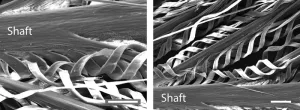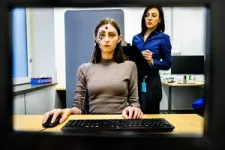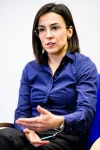(Press-News.org) Many birds’ feathers are remarkably efficient at shedding water — so much so that “like water off a duck’s back” is a common expression. Much more unusual are the belly feathers of the sandgrouse, especially Namaqua sandgrouse, which absorb and retain water so efficiently the male birds can fly more than 20 kilometers from a distant watering hole back to the nest and still retain enough water in their feathers for the chicks to drink and sustain themselves in the searing deserts of Namibia, Botswana, and South Africa.
How do those feathers work? While scientists had inferred a rough picture, it took the latest tools of microscopy, and patient work with a collection of sandgrouse feathers, to unlock the unique structural details that enable the feathers to hold water. The findings appear today in the Journal of the Royal Society Interface, in a paper by Lorna Gibson, the Matoula S. Salapatas Professor of Materials Science and Engineering and a professor of mechanical engineering at MIT, and Professor Jochen Mueller of Johns Hopkins University.
The unique water-carrying ability of sandgrouse feathers was first reported back in 1896, Gibson says, by E.G.B. Meade-Waldo, who was breeding the birds in captivity. “He saw them behaving like this, and nobody believed him! I mean, it just sounded so outlandish,” Gibson says.
In 1967, Tom Cade and Gordon MacLean reported detailed observations of the birds at watering holes, in a study that proved the unique behavior was indeed real. The scientists found that male sandgrouse feathers could hold about 25 milliliters of water, or about a tenth of a cup, after the bird had spent about five minutes dipping in the water and fluffing its feathers.
About half of that amount can evaporate during the male bird’s half-hour-long flight back to the nest, where the chicks, which cannot fly for about their first month, drink the remainder straight from the feathers.
Cade and MacLean “had part of the story,” Gibson says, but the tools didn’t exist at the time to carry out the detailed imaging of the feather structures that the new study was able to do.
Gibson and Mueller carried out their study using scanning electron microscopy, micro-computed tomography, and video imaging. They borrowed Namaqua sandgrouse belly feathers from Harvard University’s Museum of Comparative Zoology, which has a collection of specimens of about 80 percent of the world’s birds.
Bird feathers in general have a central shaft, from which smaller barbs extend, and then smaller barbules extend out from those. Sandgrouse feathers are structured differently, however. In the inner zone of the feather, the barbules have a helically coiled structure close to their base and then a straight extension. In the outer zone of the feather, the barbules lack the helical coil and are simply straight. Both parts lack the grooves and hooks that hold the vane of contour feathers together in most other birds.
When wetted, the coiled portions of the barbules unwind and rotate to be perpendicular to the vane, producing a dense forest of fibers that can hold water through capillary action. At the same time, the barbules in the outer zone curl inward, helping to hold the water in.
The microscopy techniques used in the new study allowed the dimensions of the different parts of the feather to be measured. In the inner zone, the barb shafts are large and stiff enough to provide a rigid base about which the other parts of the feather deform, and the barbules are small and flexible enough that surface tension is sufficient to bend the straight extensions into tear-like structures that hold water. And in the outer zone, the barb shafts and barbules are smaller still, allowing them to curl around the inner zone, further retaining water.
While previous work had suggested that surface tension produced the water retention characteristics, “what we did was make measurements of the dimensions and do some calculations to show that that’s what is actually happening,” Gibson says. Her group’s work demonstrated that the varying stiffnesses of the different feather parts plays a key role in their ability to hold water.
The study was mostly driven by intellectual curiosity about this unique behavioral phenomenon, Gibson says. “We just wanted to see how it works. The whole story just seemed so interesting.” But she says it might lead to some useful applications. For example, in desert regions where water is scarce but fog and dew regularly occur, such as in Chile’s Atacama Desert, some adaptation of this feather structure might be incorporated into the systems of huge nets that are used to collect water. “You could imagine this could be a way to improve those systems,” she says. “A material with this kind of structure might be more effective at fog harvesting and holding the water.”
The work was partly supported by the National Science Foundation and the Matoula S. Salapatas Professorship in Materials Science and Engineering at MIT.
###
Written by David Chandler, MIT News Office
END
Scientists uncover the amazing way sandgrouse hold water in their feathers
The structure of the desert birds’ belly feathers enables the males to carry water over long distances to their chicks
2023-04-12
ELSE PRESS RELEASES FROM THIS DATE:
Alternative route used by specialized immune cells to colonize the embryonic brain suggests new approach to fighting fetal brain dysfunction
2023-04-12
A team from the Nagoya University Graduate School of Medicine in Japan has uncovered new information about how microglia, the resident immune cells in the brain, colonize the brain during the embryonic stage of development. Although erythromyeloid progenitors (EMPs) were previously thought to divide into either microglia or macrophages, the group found that macrophages that enter the brain primordium —the brain in its earliest recognizable stage of development— can become microglia at later stages of development. These findings demonstrate the plasticity of these ...
The brain’s cannabinoid system protects against addiction following childhood maltreatment
2023-04-12
High levels of the body’s own cannabinoid substances protect against developing addiction in individuals previously exposed to childhood maltreatment, according to a new study from Linköping University in Sweden. The brains of those who had not developed an addiction following childhood maltreatment seem to process emotion-related social signals better.
Childhood maltreatment has long been suspected to increase the risk of developing a drug or alcohol addiction later in life. Researchers at Linköping University have previously shown that this risk is three times higher if you have been exposed to childhood maltreatment ...
Pregnant women show robust and variable immunity during COVID-19
2023-04-12
New research from the Peter Doherty Institute for Infection and Immunity (Doherty Institute) has found that pregnant women display a strong immune response to SARS-CoV-2 infection, comparable to that of non-pregnant women.
Published in JCI Insight, the study looked at the immune responses to SARS-CoV-2 in unvaccinated pregnant and non-pregnant women and found similar levels of antibodies and T and B cell responses, responsible for long-term protection.
Lead author of the paper, University of ...
Antimicrobial stewardship programs essential for preventing C. difficile in hospitals
2023-04-12
ARLINGTON, Va. (April 12, 2023) — Five medical organizations say it is essential that hospitals establish antimicrobial stewardship programs to prevent Clostridioides difficile (C. difficile) infections. These infections, linked to antibiotic use, cause difficult-to-treat diarrhea, longer hospital stays, and higher costs. C. difficile infections are fatal for more than 12,000 people in the United States each year.
Strategies to Prevent Clostridioides difficile Infections in Acute Care Hospitals: 2022 Update, gives evidence-based, ...
Mitochondria power-supply failure may cause age-related cognitive impairment
2023-04-12
LA JOLLA—(April 12, 2023) Brains are like puzzles, requiring many nested and codependent pieces to function well. The brain is divided into areas, each containing many millions of neurons connected across thousands of synapses. These synapses, which enable communication between neurons, depend on even smaller structures: message-sending boutons (swollen bulbs at the branch-like tips of neurons), message-receiving dendrites (complementary branch-like structures for receiving bouton messages), and power-generating mitochondria. To create a cohesive brain, all these pieces must be accounted for.
However, in the aging brain, these ...
Education and peer support cut binge-drinking by National Guard members in half, study shows
2023-04-12
A new study shows promise for reducing risky drinking among Army National Guard members over the long term, potentially improving their health and readiness to serve.
The number of days each month that Guard members said they had been binge-drinking dropped by up to half, according to the new findings by a University of Michigan team published in the journal Addiction.
The drop happened over the course of a year among Guard members who did multiple brief online education sessions designed for members of the military, and among those who did an initial online education session followed by supportive ...
World’s biggest cumulative logjam, newly mapped in the Arctic, stores 3.4 million tons of carbon
2023-04-11
WASHINGTON — Throughout the Arctic, fallen trees make their way from forests to the ocean by way of rivers. Those logs can stack up as the river twists and turns, resulting in long-term carbon storage. A new study has mapped the largest known woody deposit, covering 51 square kilometers (20 square miles) of the Mackenzie River Delta in Nunavut, Canada, and calculated that the logs store about 3.4 million tons (about 3.1 million metric tons) of carbon.
“To put that in perspective, that’s about two and a half million ...
Life cycle assessment can help with the transition to the circular economy
2023-04-11
According to Bening Mayanti's doctoral dissertation at the University of Vaasa, the use of life cycle assessment combined with economic models can help companies to take steps toward the circular economy.
– We often hear claims about some solutions being circular, sustainable, or green. Instead of blindly accepting those claims, we should ask justifications, ‘How so?’ says Mayanti, who publicly defended her dissertation on Wednesday, 5 April.
Before deciding on circular economy solutions and building supply chains, it is worth doing a careful analysis. ...
From waste to wonder: unlocking nature’s biochemical recycling secrets
2023-04-11
A new perspective published in the journal Nature Chemical Biology uncovers a previously unknown biochemical recycling process in animals. The authors review a flurry of recent papers demonstrating that animals extensively recycle biochemical waste to produce novel chemicals that play key roles in biology, from regulating behavior to development and aging.
These studies show that the genes previously thought to code for carboxylesterases, enzymes that hydrolyze esters, actually play a pivotal role in assembling a wide range of new metabolites from building blocks generally considered “cellular waste.” Surprisingly, the so-called carboxylesterases were found to contribute ...
Yossi Sheffi on AI and the future of the supply chain
2023-04-11
Global supply chains are immense feats of technological and organizational sophistication. They are also, as the onset of the Covid-19 pandemic showed, vulnerable to unexpected developments. Will that change as artificial intelligence becomes a bigger part of supply chains? And what will happen to workers in the process?
MIT Professor Yossi Sheffi explores these topics in a new book, “The Magic Conveyor Belt: AI, Supply Chains, and the Future of Work,” published by MIT’s CTL Media. Sheffi, the Elisha Gray II Professor of Engineering ...
LAST 30 PRESS RELEASES:
Why nail-biting, procrastination and other self-sabotaging behaviors are rooted in survival instincts
Regional variations in mechanical properties of porcine leptomeninges
Artificial empathy in therapy and healthcare: advancements in interpersonal interaction technologies
Why some brains switch gears more efficiently than others
UVA’s Jundong Li wins ICDM’S 2025 Tao Li Award for data mining, machine learning
UVA’s low-power, high-performance computer power player Mircea Stan earns National Academy of Inventors fellowship
Not playing by the rules: USU researcher explores filamentous algae dynamics in rivers
Do our body clocks influence our risk of dementia?
Anthropologists offer new evidence of bipedalism in long-debated fossil discovery
Safer receipt paper from wood
Dosage-sensitive genes suggest no whole-genome duplications in ancestral angiosperm
First ancient human herpesvirus genomes document their deep history with humans
Why Some Bacteria Survive Antibiotics and How to Stop Them - New study reveals that bacteria can survive antibiotic treatment through two fundamentally different “shutdown modes”
UCLA study links scar healing to dangerous placenta condition
CHANGE-seq-BE finds off-target changes in the genome from base editors
The Journal of Nuclear Medicine Ahead-of-Print Tip Sheet: January 2, 2026
Delayed or absent first dose of measles, mumps, and rubella vaccination
Trends in US preterm birth rates by household income and race and ethnicity
Study identifies potential biomarker linked to progression and brain inflammation in multiple sclerosis
Many mothers in Norway do not show up for postnatal check-ups
Researchers want to find out why quick clay is so unstable
Superradiant spins show teamwork at the quantum scale
Cleveland Clinic Research links tumor bacteria to immunotherapy resistance in head and neck cancer
First Editorial of 2026: Resisting AI slop
Joint ground- and space-based observations reveal Saturn-mass rogue planet
Inheritable genetic variant offers protection against blood cancer risk and progression
Pigs settled Pacific islands alongside early human voyagers
A Coral reef’s daily pulse reshapes microbes in surrounding waters
EAST Tokamak experiments exceed plasma density limit, offering new approach to fusion ignition
Groundbreaking discovery reveals Africa’s oldest cremation pyre and complex ritual practices
[Press-News.org] Scientists uncover the amazing way sandgrouse hold water in their feathersThe structure of the desert birds’ belly feathers enables the males to carry water over long distances to their chicks








